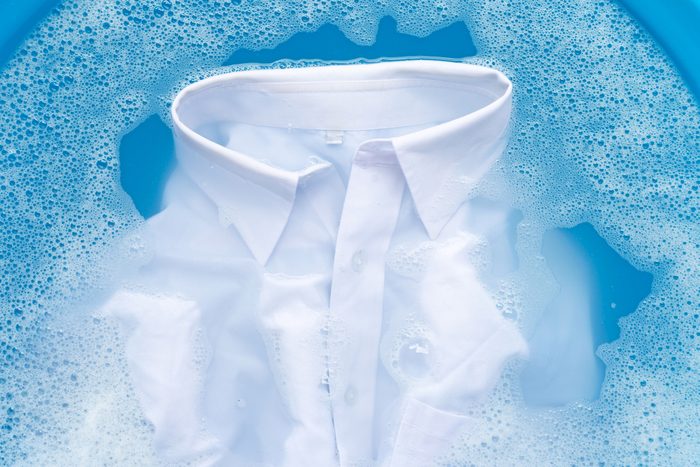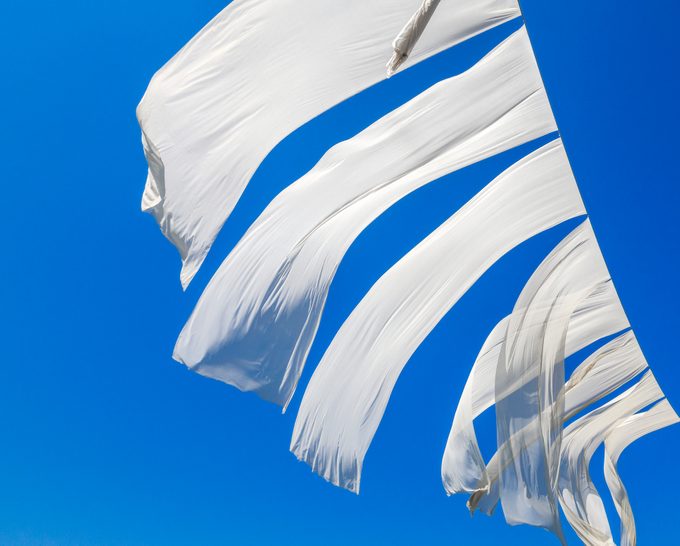What Is Laundry Bluing?

Discover how you can use laundry bluing to whiten your clothes or darken your jeans.
Our editors and experts handpick every product we feature. We may earn a commission from your purchases.
If you’re anything like us, you’re always on the hunt for tips to make doing your laundry easier and more efficient. And if you’ve battled white clothing that won’t lose that dingy yellow tint or faded jeans, you know how frustrating doing your laundry can be.
Thankfully, there’s a method you can use to solve both of those problems. It’s called laundry bluing, and today, we’re going to share how you can get started.
What Is Laundry Bluing?
If you’re scratching your head wondering, “What is laundry bluing?” you’ll be happy to learn it isn’t as complicated as it sounds. Basically, you can use a product to add a small amount of blue dye to effectively help you brighten white clothing or darken jeans that have faded. The key with laundry bluing is to be mindful of your dye concentration, as a higher concentration will darken jeans but could tarnish your white clothing.
Yep, while it might sound counterintuitive, a little bit of blue dye can make your white clothes, well—whiter. The pigment in the blue dye counteracts the yellow that happens as you wash your white clothes, which is why it’s a perfect quick fix. And if you didn’t know already, you should avoid using bleach for white laundry.
The product used, liquid bluing, is simply a colloidal suspension of very fine blue iron powder and water. And no, you don’t need to make it yourself—just buy a laundry bluing product like Mrs. Stewart’s.
How to Use Laundry Bluing
It seems simple enough, right? However, depending on which type of washing machine you have, you’ll need to follow a particular process to make laundry bluing as successful as possible. Regardless of how you add the bluing mix, be sure you skip any other laundry products (like fabric softener) aside from detergent. This is a common laundry mistake, but it will lead to staining.
In a Top Load Washer
Dilute 1/4 teaspoon of bluing with 1 quart of cold water of the bluing substance, or follow the instructions on the package. Then, begin the wash cycle and monitor the barrel until it’s halfway full of water. At that point, add the solution.
In a Front Load Washer
Dilute 1/4 teaspoon of bluing with 1-2 quarts of cold water, or as it instructs you on the bottle you’re using. Once your machine fills with water, add the mixture to the dispenser drawer.
However, if your washer’s drawers lock when your washing cycle begins, you can dilute the substance according to the bottle’s instructions and pour it into your washer’s available drawer.
These are the instructions you’d follow if you want to whiten your clothing. However, if you want to make jeans darker, you’ll use more bluing substance—up to one teaspoon for every quart of water you use. Of course, the more you use, the darker the jeans will be.
How to Remove Laundry Bluing Stains
Usually, we’d say too much of a good thing is impossible, but this isn’t the case with laundry bluing. If you got a bit too enthusiastic using this method and now need to remove laundry bluing stains, we’ve been there. Here’s the good news: removing these marks isn’t as tricky as it seems, and Mrs. Stewart’s provides an excellent tutorial that should help remove any stains. Here’s how to do it.
To start, gather your clothing into a container that you can cover. For instance, try a plastic bag with a twist tie that you then place in another bag or a bucket with a tight-fitting lid. It’s essential there are no leaks and that it’s airtight.
Then, create a solution of 1/2 cup ammonia to one quart of water. Ammonia is the only way to remove your bluing stains. For the best results, the water needs to be cold, and there needs to be enough solution to submerge your clothing entirely. In addition, your items will need to float in it.
Soak your clothes for 24 hours, and check on your clothing. If it’s gone, you’re all set, and you can now wash your clothing as normal, but use a non-bleach detergent. If it’s still visible yet fading, soak it for another 24 hours.




